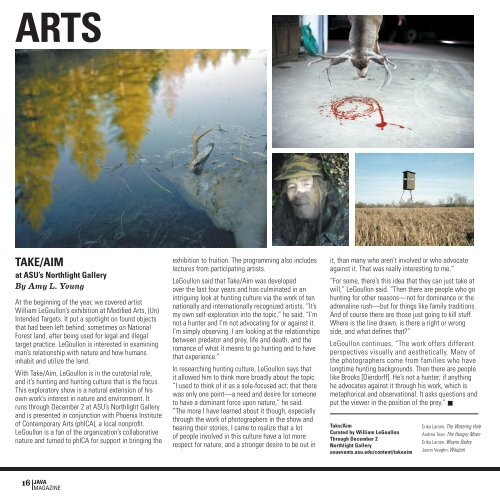Java.NOV.2016
You also want an ePaper? Increase the reach of your titles
YUMPU automatically turns print PDFs into web optimized ePapers that Google loves.
ARTS<br />
TAKE/AIM<br />
at ASU’s Northlight Gallery<br />
By Amy L. Young<br />
At the beginning of the year, we covered artist<br />
William LeGoullon’s exhibition at Modified Arts, (Un)<br />
Intended Targets. It put a spotlight on found objects<br />
that had been left behind, sometimes on National<br />
Forest land, after being used for legal and illegal<br />
target practice. LeGoullon is interested in examining<br />
man’s relationship with nature and how humans<br />
inhabit and utilize the land.<br />
With Take/Aim, LeGoullon is in the curatorial role,<br />
and it’s hunting and hunting culture that is the focus.<br />
This exploratory show is a natural extension of his<br />
own work’s interest in nature and environment. It<br />
runs through December 2 at ASU’s Northlight Gallery<br />
and is presented in conjunction with Phoenix Institute<br />
of Contemporary Arts (phICA), a local nonprofit.<br />
LeGoullon is a fan of the organization’s collaborative<br />
nature and turned to phICA for support in bringing the<br />
exhibition to fruition. The programming also includes<br />
lectures from participating artists.<br />
LeGoullon said that Take/Aim was developed<br />
over the last four years and has culminated in an<br />
intriguing look at hunting culture via the work of ten<br />
nationally and internationally recognized artists. “It’s<br />
my own self-exploration into the topic,” he said. “I’m<br />
not a hunter and I’m not advocating for or against it.<br />
I’m simply observing. I am looking at the relationships<br />
between predator and prey, life and death, and the<br />
romance of what it means to go hunting and to have<br />
that experience.”<br />
In researching hunting culture, LeGoullon says that<br />
it allowed him to think more broadly about the topic.<br />
“I used to think of it as a sole-focused act; that there<br />
was only one point—a need and desire for someone<br />
to have a dominant force upon nature,” he said.<br />
“The more I have learned about it though, especially<br />
through the work of photographers in the show and<br />
hearing their stories, I came to realize that a lot<br />
of people involved in this culture have a lot more<br />
respect for nature, and a stronger desire to be out in<br />
it, than many who aren’t involved or who advocate<br />
against it. That was really interesting to me.”<br />
“For some, there’s this idea that they can just take at<br />
will,” LeGoullon said. “Then there are people who go<br />
hunting for other reasons—not for dominance or the<br />
adrenaline rush—but for things like family traditions.<br />
And of course there are those just going to kill stuff.<br />
Where is the line drawn, is there a right or wrong<br />
side, and what defines that?”<br />
LeGoullon continues, “The work offers different<br />
perspectives visually and aesthetically. Many of<br />
the photographers come from families who have<br />
longtime hunting backgrounds. Then there are people<br />
like Brooks [Dierdorff]. He’s not a hunter; if anything<br />
he advocates against it through his work, which is<br />
metaphorical and observational. It asks questions and<br />
put the viewer in the position of the prey.”<br />
Take/Aim<br />
Curated by William LeGoullon<br />
Through December 2<br />
Northlight Gallery<br />
asuevents.asu.edu/content/takeaim<br />
Erika Larsen, The Watering Hole<br />
Andrea Tese, The Hungry Moon<br />
Erika Larsen, Wayne Bailey<br />
Jason Vaughn, Waupun<br />
16 JAVA<br />
MAGAZINE


















